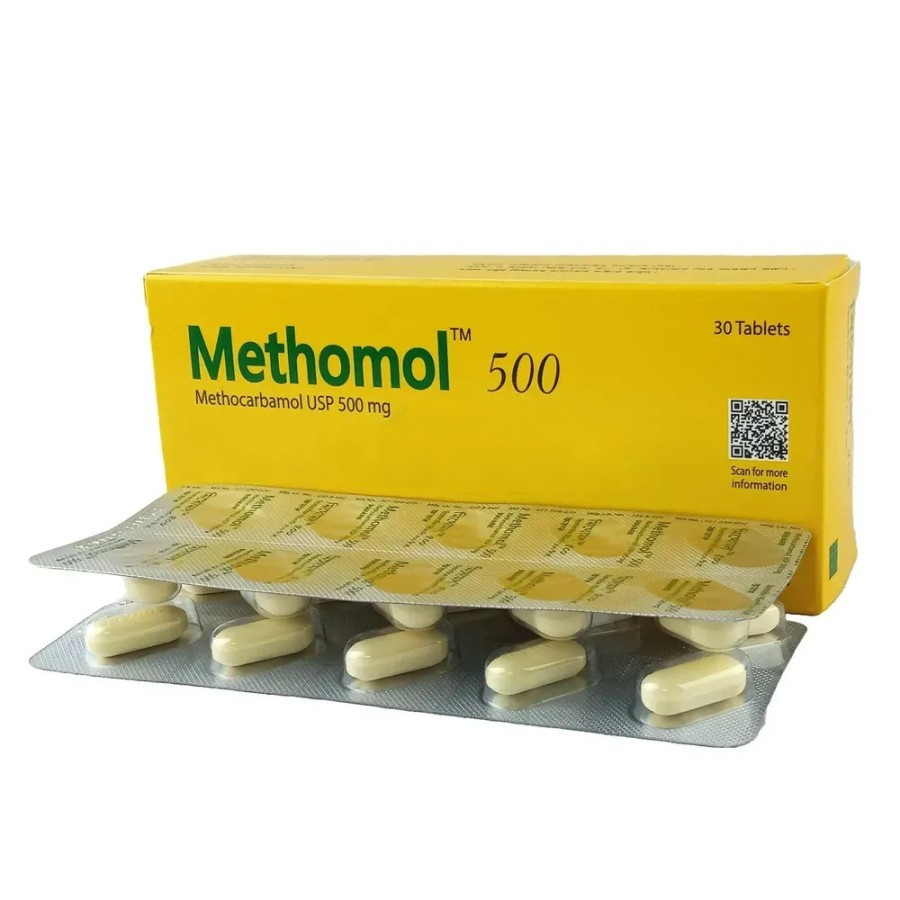Unit Price:
৳ 10.00
(3 x 10: ৳ 300.00)
Strip Price:
৳ 100.00
Also available as:
Indications
Methomol tablet is indicated as an adjunct to rest, physical therapy, and other measures for the relief of discomfort associated with acute, painful musculoskeletal conditions. The mode of action of Methomol has not been clearly identified, but may be related to its sedative properties. Methomol does not directly relax tense skeletal muscles in man.
* রেজিস্টার্ড চিকিৎসকের পরামর্শ মোতাবেক ঔষধ সেবন করুন
Pharmacology
The mechanism of action of methocarbamol is thought to be dependant on its central nervous system depressant activity. This action may be mediated through blocking spinal polysynaptic reflexes, decreasing nerve transmission in spinal and supraspinal polysynaptic pathways, and prolonging the refractory period of muscle cells. Methocarbamol has been found to have no effect on contraction of muscle fibres, motor end plates, or nerve fibres.
Dosage & Administration
Route of Administration: Oral
Methocarbamol 500 mg- Adults:
Pediatric Use: Safety and effectiveness of Methocarbamol in pediatric patients below the age of 16 have not been established.
Methocarbamol 500 mg- Adults:
- Initial dosage: 3 tablets q.i.d.
- Maintenance dosage: 2 tablets q.i.d.
- Initial dosage: 2 tablets q.i.d.
- Maintenance dosage: 1 tablet q.4h. or 2 tablets t.i.d.
Pediatric Use: Safety and effectiveness of Methocarbamol in pediatric patients below the age of 16 have not been established.
* রেজিস্টার্ড চিকিৎসকের পরামর্শ মোতাবেক ঔষধ সেবন করুন
Interaction
Methomol may inhibit the effect of Pyridostigmine Bromide. Therefore, Methomol should be used with caution in patients with myasthenia gravis receiving anticholinesterase agents.
Drug/Laboratory Test Interactions: Methomol may cause a color interference in certain screening tests for 5-hydroxyindoleacetic acid (5-HIAA) using nitrosonaphthol reagent and in screening tests for urinary vanillylmandelic acid (VMA) using the Gitlow method. Carcinogenesis, Mutagenesis, Impairment of Fertility Long-term studies to evaluate the carcinogenic potential of Methomol have not been performed. No studies have been conducted to assess the effect of Methomol on mutagenesis or its potential to impair fertility.
Drug/Laboratory Test Interactions: Methomol may cause a color interference in certain screening tests for 5-hydroxyindoleacetic acid (5-HIAA) using nitrosonaphthol reagent and in screening tests for urinary vanillylmandelic acid (VMA) using the Gitlow method. Carcinogenesis, Mutagenesis, Impairment of Fertility Long-term studies to evaluate the carcinogenic potential of Methomol have not been performed. No studies have been conducted to assess the effect of Methomol on mutagenesis or its potential to impair fertility.
Contraindications
Methocarbamol is contraindicated in patients hypersensitive to Methocarbamol or to any of the tablet components.
Side Effects
Adverse reactions reported coincident with the administration of Methomol include:
Body as a whole: Anaphylactic reaction, angioneurotic edema, fever, headache
Cardiovascular system: Bradycardia, flushing, hypotension, syncope, thrombo- phlebitis
Digestive system: Dyspepsia, jaundice (including cholestatic jaundice), nausea and vomiting
Hemic and lymphatic system: Leukopenia
Immune system: Hypersensitivity reactions
Nervous system: Amnesia, confusion, Diplopia, dizziness or lightheadedness, drowsiness, insomnia, mild muscular incoordination, nystagmus, sedation, seizures (including grand mal), vertigo
Skin and special senses: Blurred vision, conjunctivitis, nasal congestion, metallic taste, pruritus, rash, urticaria.
Body as a whole: Anaphylactic reaction, angioneurotic edema, fever, headache
Cardiovascular system: Bradycardia, flushing, hypotension, syncope, thrombo- phlebitis
Digestive system: Dyspepsia, jaundice (including cholestatic jaundice), nausea and vomiting
Hemic and lymphatic system: Leukopenia
Immune system: Hypersensitivity reactions
Nervous system: Amnesia, confusion, Diplopia, dizziness or lightheadedness, drowsiness, insomnia, mild muscular incoordination, nystagmus, sedation, seizures (including grand mal), vertigo
Skin and special senses: Blurred vision, conjunctivitis, nasal congestion, metallic taste, pruritus, rash, urticaria.
Pregnancy & Lactation
Pregnancy Category C. Animal reproduction studies have not been conducted with Methocarbamol. It is also not known whether Methocarbamol can cause fetal harm when adminis- tered to a pregnant woman or can affect reproduction capacity. Methocarbamol should be given to a pregnant woman only if clearly needed. Methocarbamol and/or its metabolites are excreted in the milk of dogs; however, it is not known whether Methocarbamol or its metabolites are excreted in human milk. Because many drugs are excreted in human milk, caution should be exercised when Methocarbamol is administered to a nursing woman.
Precautions & Warnings
Patients should be cautioned that Methomol may cause drowsiness or dizziness, which may impair their ability to operate motor vehicles or machinery because Methomol may possess a general CNS-depressants effect. Patients should be cautioned about combined effects with alcohol and other CNS depressants. Safe use of Methomol has not been established with regard to possible adverse effects upon fetal development. There have been reports of fetal and congenital abnormalities following in utero exposure to Methomol. Therefore, Methomol should not be used in women who are or may become pregnant and particularly during early pregnancy unless in the judgment of the physician the potential benefits outweigh the possible hazards.
Overdose Effects
Limited information is available on the acute toxicity of Methomol. Overdose of Methomol is frequently in conjunction with alcohol or other CNS depressants and includes the following symptoms: nausea, drowsiness, blurred vision, hypotension, seizures, and coma. In post-marketing experience, deaths have been reported with an overdose of Methomol alone or in the presence of other CNS depressants, alcohol or psychotropic drugs.
Management of overdose includes symptomatic and supportive treatment. Supportive measures include maintenance of an adequate airway, monitoring urinary output and vital signs, and administration of intravenous fluids if necessary. The usefulness of hemodialysis in managing overdose is unknown.
Management of overdose includes symptomatic and supportive treatment. Supportive measures include maintenance of an adequate airway, monitoring urinary output and vital signs, and administration of intravenous fluids if necessary. The usefulness of hemodialysis in managing overdose is unknown.
Therapeutic Class
Centrally acting Skeletal Muscle Relaxants
Storage Conditions
Protect from light, store below 30°C. Keep the medicine out of the reach of children.

